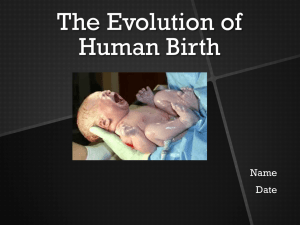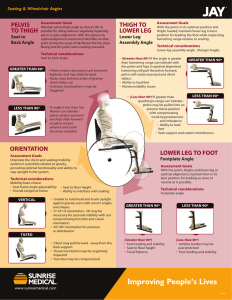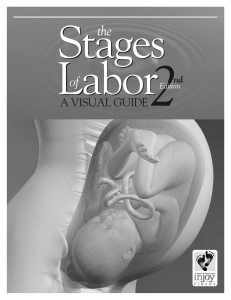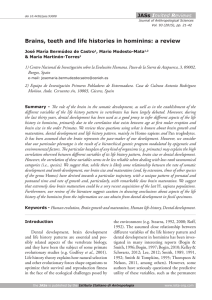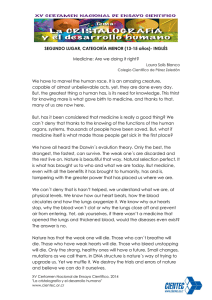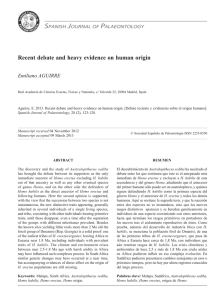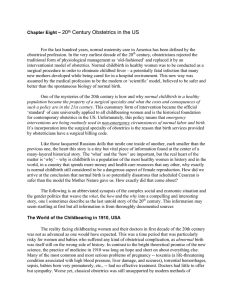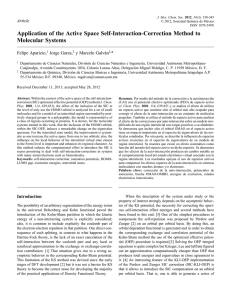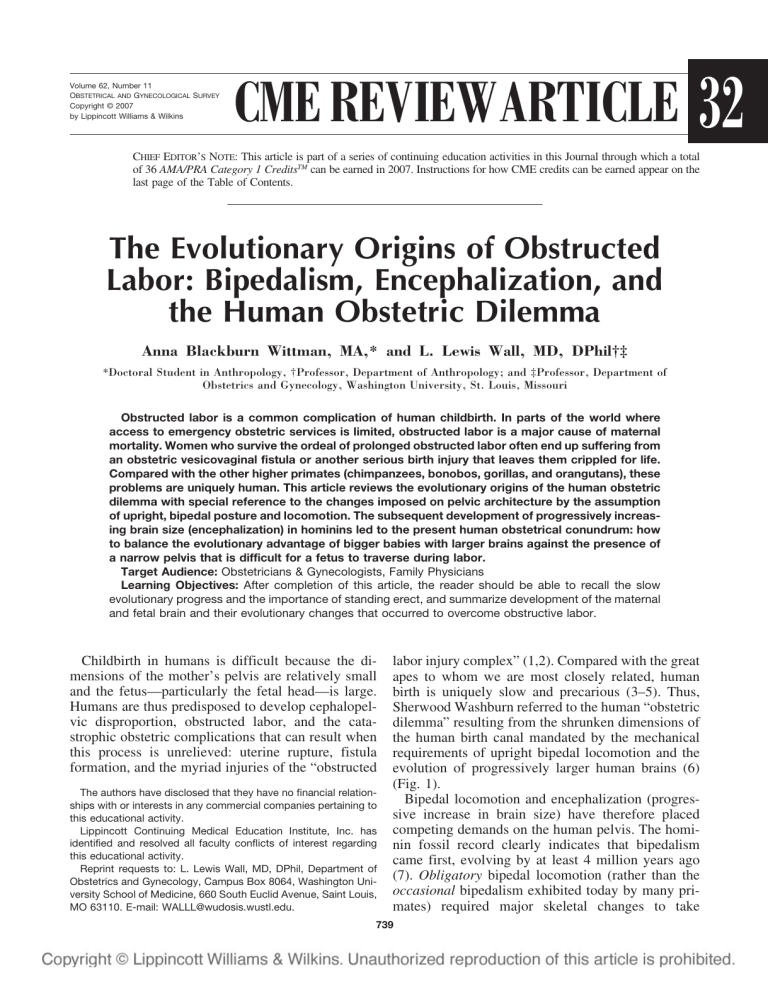
Volume 62, Number 11 OBSTETRICAL AND GYNECOLOGICAL SURVEY Copyright © 2007 by Lippincott Williams & Wilkins CME REVIEWARTICLE 32 CHIEF EDITOR’S NOTE: This article is part of a series of continuing education activities in this Journal through which a total of 36 AMA/PRA Category 1 CreditsTM can be earned in 2007. Instructions for how CME credits can be earned appear on the last page of the Table of Contents. The Evolutionary Origins of Obstructed Labor: Bipedalism, Encephalization, and the Human Obstetric Dilemma Anna Blackburn Wittman, MA,* and L. Lewis Wall, MD, DPhil†‡ *Doctoral Student in Anthropology, †Professor, Department of Anthropology; and ‡Professor, Department of Obstetrics and Gynecology, Washington University, St. Louis, Missouri Obstructed labor is a common complication of human childbirth. In parts of the world where access to emergency obstetric services is limited, obstructed labor is a major cause of maternal mortality. Women who survive the ordeal of prolonged obstructed labor often end up suffering from an obstetric vesicovaginal fistula or another serious birth injury that leaves them crippled for life. Compared with the other higher primates (chimpanzees, bonobos, gorillas, and orangutans), these problems are uniquely human. This article reviews the evolutionary origins of the human obstetric dilemma with special reference to the changes imposed on pelvic architecture by the assumption of upright, bipedal posture and locomotion. The subsequent development of progressively increasing brain size (encephalization) in hominins led to the present human obstetrical conundrum: how to balance the evolutionary advantage of bigger babies with larger brains against the presence of a narrow pelvis that is difficult for a fetus to traverse during labor. Target Audience: Obstetricians & Gynecologists, Family Physicians Learning Objectives: After completion of this article, the reader should be able to recall the slow evolutionary progress and the importance of standing erect, and summarize development of the maternal and fetal brain and their evolutionary changes that occurred to overcome obstructive labor. Childbirth in humans is difficult because the dimensions of the mother’s pelvis are relatively small and the fetus—particularly the fetal head—is large. Humans are thus predisposed to develop cephalopelvic disproportion, obstructed labor, and the catastrophic obstetric complications that can result when this process is unrelieved: uterine rupture, fistula formation, and the myriad injuries of the “obstructed The authors have disclosed that they have no financial relationships with or interests in any commercial companies pertaining to this educational activity. Lippincott Continuing Medical Education Institute, Inc. has identified and resolved all faculty conflicts of interest regarding this educational activity. Reprint requests to: L. Lewis Wall, MD, DPhil, Department of Obstetrics and Gynecology, Campus Box 8064, Washington University School of Medicine, 660 South Euclid Avenue, Saint Louis, MO 63110. E-mail: [email protected]. labor injury complex” (1,2). Compared with the great apes to whom we are most closely related, human birth is uniquely slow and precarious (3–5). Thus, Sherwood Washburn referred to the human “obstetric dilemma” resulting from the shrunken dimensions of the human birth canal mandated by the mechanical requirements of upright bipedal locomotion and the evolution of progressively larger human brains (6) (Fig. 1). Bipedal locomotion and encephalization (progressive increase in brain size) have therefore placed competing demands on the human pelvis. The hominin fossil record clearly indicates that bipedalism came first, evolving by at least 4 million years ago (7). Obligatory bipedal locomotion (rather than the occasional bipedalism exhibited today by many primates) required major skeletal changes to take 739 740 Obstetrical and Gynecological Survey Fig. 1. Relationships between the fetal head and maternal pelvis in higher primates: Pongo (orangutan), Pan (chimpanzee), Gorilla (gorilla), and humans. Redrawn from Schultz (1969) and Leutenegger (1982). Copyright Worldwide Fistula Fund, used by permission. place—particularly in the pelvis—to maintain balance in the upright position and support body weight most effectively. Such changes included anterior movement of the foramen magnum to a more central location, thereby improving central balance of the skull; anterior displacement of the sacrum to stabilize the spine (which also developed cervical and lumbar curves); lengthening of the lower extremities in relation to the upper extremities, providing better mechanical advantage for the muscles of the leg; development of “valgus knees” to bring them under the midline of the body for improved balance and stability; development of a stable plantar foot (with consequent loss of an opposable great toe); and multiple changes in pelvic architecture that altered it from a simple cylinder to a complex structure in which the planes of the pelvic inlet, midpelvis, and outlet are all misaligned (8,9). Although modest increases in hominin brain size are evident by 1.8 million years ago, the last 600,000 years have seen the most substantial increase in cranial capacity in the evolution of Homo (10). The likelihood of cephalopelvic disproportion and obstructed labor has increased along with the increase in brain size. Selective evolutionary pressures have modified the morphology of the human pelvis, producing pronounced anatomic differences between the sexes (Fig. 2). The female pelvis has been modified in ways that make parturition easier; the male pelvis has not. Some of the architectural constraints on the pelvis have been partially offset by the great malleability of the fetal head, a trait that is more pronounced in humans than in other primates (9), and secondary altriciality—the delivery of a less-developed neonate Fig. 2. Sexual differences in human pelvic morphology. Copyright Worldwide Fistula Fund, used by permission. who matures outside rather than inside the womb (11). Although these facts demonstrate the selective evolutionary pressure of parturition, the structure of the modern human pelvis has been largely determined by the obligate upright bipedal locomotion uniquely characteristic of our species. Over the last 50 years, anthropologists have developed a narrative describing the evolution of human birth based on rather limited fossil evidence and observations about parturition in other primates. From this evidence, it appears that birth mechanics changed dramatically once our early ancestors developed a bipedal gait, but that the rotational obstetrical mechanics characteristic of modern humans did not develop until encephalization became pronounced around 500,000 years ago. In these events lie the origins of many of the traumatic birth injuries seen today. A Brief Synopsis of Human Evolution A discussion of the evolution of human obstetrical mechanics must be set within the context of what is known about human evolution in general (12–14). In the standard zoological taxonomy, modern humans (Homo sapiens) are the only living representatives of the family Hominidae, which is part of the order Primates (which includes lemurs and monkeys as well as the great apes: chimpanzees, bonobos, gorillas, and orangutans, species to which humans are Evolutionary Origins of Obstructed Labor Y CME Review Article closely related). Hominins are bipedal apes; in the past, our hominin family contained a number of species, all bipedal but differing substantially in brain size, dental structure, and behavior. Today our closest living relatives are the great apes, particularly the chimpanzee with whom we share over 98% of our DNA (15) (a finding that has led some to advocate grouping these species in the same subfamily of Homininae) (16). Genetic analysis suggests that hominins and chimpanzees diverged from a common ancestor between 4 million and 7 million years ago (17,18). The earliest fossil currently thought to represent a hominin ancestor is a cranium from Sahelanthropus tchadensis, discovered in Chad and dated to about 7 million years ago (19). Although no postcranial remains have been recovered as yet, the anterior orientation of the foramen magnum suggests this species had a bipedal posture (19,20), and its early date places it near the node of the evolutionary split which separated our early human ancestors from the ancestors of modern chimpanzees. After 4 million years ago, the fossil record becomes much richer, and allows a generally accepted outline of hominin evolution to be depicted (Fig. 3). Abundant fossil specimens of an early hominin genus (Australopithecus sp.) have been recovered from east and south Africa. Two groups of australopithecines, Fig. 3. Timeline of hominin evolution. Copyright Worldwide Fistula Fund, used by permission. 741 “gracile” and “robust” types, lived between 4 million and 1 million years ago. The gracile species predate the robust species, although they overlap for a time approximately 2.5 million years ago. Both groups had brains and bodies that were smaller than those of later hominins. Australopithecine cranial capacity was around 450 mL, slightly larger than the modern chimpanzee brain. Different diets led these 2 groups of australopithecines to differ dramatically in the shape and function of their teeth and jaws. The robust species had extremely large teeth, and massive attachment sites for the muscles of mastication. Both groups were herbivorous and the exact nature of their diets is debated, but gracile australopithecines probably ate more seeds and soft fruits, whereas their robust cousins were generalized omnivores (21,22). The australopithecines were habitual bipeds and walked upright, yet retained anatomical features, suggesting that movement through the trees was common and much easier for them than for later more obligatory bipedal hominins (7). The trend toward increasing brain size began around 2.4 million years ago within the robust australopithecine clade. Modest increases continued in Homo habilis, the earliest known representative of our genus, around 1.9 million years ago. Although this species had a cranial capacity ranging between only 503 and 661 mL, the retention of small body size increased the brain-to-body ratio, thus making H. habilis slightly more encephalized than the australopithecines (23). Brain size increased to approximately 900 mL in Homo erectus, but modern levels of encephalization were not reached until after 500,000 years ago (10,24). With larger brains came more advanced tool technology and altered subsistence patterns including a greater reliance on hunting (25,26). At the same time, early members of the genus Homo began to move out of Africa, spreading into Europe and Asia. Homo erectus fossils from about 1.8 million years ago have been found in such disparate locations as the former Soviet Georgia (27) and by 800,000 years ago on the island of Java in Indonesia (28). DNA evidence suggests that once early Homo had dispersed through the Old World, episodic immigration of human groups from Africa into Europe and Asia occurred periodically over the last 500,000 years, with the newer incoming groups interbreeding with the preexisting populations they encountered (29). Anatomically modern humans originated in Africa. New fossil finds from the site of Herto in Ethiopia dated to about 160,000 years ago show facial features intermediate between the archaic H. 742 Obstetrical and Gynecological Survey sapiens known from Africa from earlier periods and anatomically modern humans (30). By about 35,000 years ago, anatomically modern humans had spread throughout the Old World, navigated the seas to reach Australia and Japan, and by 13,000 years ago had colonized North America. A “revolution” in culture and technology accompanied the territorial expansion of these modern humans distinguished by new types of tools, artistic expression (in the form of body adornment and painting), long-distance trade networks, and ritual internment of the dead. These practices have led to much speculation about the cognitive capabilities of early modern humans and their predecessors, who also used cultural innovations, including the use of caves and controlled fire, to survive in difficult environments for hundreds of thousands of years. Bipedalism Within the mammal world, bipedalism is a unique form of locomotion. A number of mammalian species walk upright occasionally (bears, meerkats, etc.) and some primates assume an upright posture for brief periods of time, but only humans are obligate bipeds. Bipedal locomotion has enormous obstetric implications because it requires major alterations in the shape of the pelvis (8,31–33). Why humans developed bipedal locomotion has preoccupied anthropologists for over 100 years, without the emergence of an agreed-upon hypothesis that can be satisfactorily tested with the available data (34). Richmond et al (34) aptly described the conundrum in the following statement: “. . . many scenarios (for the origin of bipedalism) are difficult or impossible to test. While untestable hypotheses are not particularly useful, we are left with the unsatisfying possibility that one or more of them may actually be correct.” Until the 1950s, the dominant view regarding the origins of bipedalism assumed that upright posture developed because it freed the hands for tool manipulation (35). In The Descent of Man (1871), Charles Darwin (36) argued that the “prehensile” use of the hands could only be attained when humans assumed an erect posture, which freed them to use weapons for defense or in hunting. Over the next 70 years, many authors made similar arguments linking tool use and bipedalism, but in the second half of the twentieth century, new fossil discoveries clearly established that bipedal locomotion actually predated the first use of stone tools by at least 1.5 million years, thus requiring new explanations for the origin of bipedalism (35). Perhaps the most dramatic of these discoveries was a trail of 3 sets of footprints made in volcanic ash by upright, bipedal hominins at Laetoli, Tanzania, 3.6 million years ago (37). Based on anatomical comparisons, the last common ancestor of chimpanzees and humans is thought to have been a knuckle-walking ape (as are chimpanzees and gorillas today) (34). Environmental shifts in Africa between 7 million and 5 million years ago created a habitat in which areas of woodland were interspersed with grassy patches that early hominins had to traverse to reach feeding trees (38). Bipedalism may well have been advantageous in this context. Standing erect while feeding would allow both hands to be used for fruit collection, which is the most labor-intensive part of feeding (34). Furthermore, energy economy may have been important in the evolution of bipedalism. This conclusion is supported by the greater efficiency of human walking compared with locomotion in chimpanzees, whose mode of locomotion is presumably similar to that of our ape-like ancestors (39). Chimpanzees spend a large percentage of their daily energy expenditures in terrestrial locomotion; so, in a context where food resources became more widely distributed, decreasing energy expenditures may have been advantageous for early hominins (40). Major changes in body structure later in hominin evolution (including longer legs (41–43) and changes in pelvic shape (44)) indicate that long-distance travel became increasingly important, as the African landscape became drier and the savanna grasslands developed. Changes in the Bony Pelvis Produced by Bipedalism Whatever the reason for our ancestors’ bipedalism, this posture required major changes in the shape and orientation of the bony pelvis (32,45,46). In quadrupeds, the ilium is long and blade-like. In humans, this bone is short and broad (31,45) and has also been reoriented so that the walls of the pelvis face laterally (32). This increases the area for attachment of the gluteus medius and gluteus minimus muscles, which stabilize the torso in the mediolateral plane during single leg support. The human sacrum is also broad and pushed caudally better to support body weight during erect posture (8,31). Each of these adaptations is required to maintain balance around the central axis during bipedal locomotion (45). Although increased sacral width is related to the mechanical requirements of bipedalism (and does Evolutionary Origins of Obstructed Labor Y CME Review Article not vary between males and females (47)), a widened sacrum also increases the transverse diameter of the birth canal and confers advantages during parturition (31). At the same time, however, the ischial spines have become more prominent and have moved medially to provide larger attachment sites for the ligaments which help support the abdominal viscera in the erect posture (8,48). Unfortunately, these changes greatly restrict the midplane of the pelvis, complicating human obstetrical mechanics. These changes in pelvic morphology are clearly visible in the 3.2-million-year-old fossil of Australopithecus afarensis popularly known as “Lucy” (7). Although bipedalism predates Lucy, her remarkably intact skeleton (which includes a complete innominate bone and sacrum) is the oldest fossil evidence documenting the effects of bipedalism on pelvic architecture. Lucy’s pelvis shows all of the unique morphological traits described above, but differs substantially from the modern human pelvis in being hyperplatypelloid in shape (49), a configuration with major implications for australopithecine obstetrics. The anatomic rearrangement of the pelvis in relation to bipedalism constrained obstetrical mechanics in ways that continue to create difficulties for modern humans. Encephalization Brain-Body Relationships in Mammals and Humans A large literature assesses the relationship between brain size and body size in mammals (11). Comparative zoological analysis clearly shows that the size of the human brain is anomalous, as humans have brains that are significantly larger than would be expected for an animal of our size (48). Even among the great apes, we are distinctive in this regard, having brains 3 to 4 times larger than those of chimpanzees, our nearest relatives (50). However, the earliest hominins had brains that were not much larger than those of modern chimps; cranial capacity in Australopithecus was about 450 mL (51). Only in the last 1 million years, has brain size increased substantially, with early modern humans having a cranial capacity of about 1350 mL and some Neanderthal specimens reaching cranial capacities as high as 1750 mL (51) (Fig. 4). These comparisons imply great leaps in cognitive ability during our evolution, but the 743 Fig. 4. Progressive encephalization (increasing cranial capacity) in hominin evolution. Copyright Worldwide Fistula Fund, used by permission. explanation for why our brains became so large continues to be elusive. Selective Forces Driving Encephalization Encephalization in the hominin lineage was probably brought about by ecological and/or social pressures. The ecological explanations suggest that animals exploiting food resources that are widely scattered in the environment or that are only available seasonally (such as fruit) need better memory and spatial mapping skills to be successful in finding food. If such food items require special processing (like the removal of tough skins or seeds), this requires greater manual dexterity and better hand-eye coordination. Such mental skills are advantageous, and selection acts to increase brain size. Harvey et al (52) have found a close relationship between diet and brain size in mammals, showing that leaf eaters have smaller brains than fruit eaters, but this comes at a cost. Larger brains are expensive to grow and maintain (11,25,51), and this suggests a feedback loop between the procurement of difficult-to-obtain foods and the energy rewards they provide. Calorie-rich fruit and meat reduce the metabolic energy that needs to be spent on digestion and allows more energy to be channeled to the brain. The “expensive tissue hypothesis” (25) proposes that during hominin evolution, brain size began to increase when greater quantities of meat were incorporated into the diet, thereby allowing the diversion of energy resources away from a long, metabolically expensive gastrointestinal tract toward a larger brain. Social theories of hominin encephalization revolve around the idea that behavioral flexibility and the ability to learn from others both require an increase in cognitive abilities (i.e., brain size). Correlations among complex social behaviors, learning, and brain size have been 744 Obstetrical and Gynecological Survey observed in many primate species (53,54), but there is no consensus yet on how such group interactions build intelligence. Correlations among brain size, group size, and the amount of time engaged in social grooming in primates support the view that the evolution of large social groups required larger brains to maintain group cohesion and, possibly as a consequence, more sophisticated means of communication such as language developed (55). Deceptive behavior also seems tied to encephalization rates in primates (53,56) and suggests that large brains carry with them Machiavellian potentialities as well. mate (Fig. 6) (57). These relationships indicate that human mothers devote a large proportion of their metabolic energy during pregnancy toward fetal growth (11). Because the brain-body relationship in humans does not diverge from the general primate pattern of growth at birth, to reach full adult size, the neonate’s brain growth must continue at an accelerated rate outside the womb (11), a process known as secondary altriciality. This postnatal brain growth is likely an adaptation that allows increased encephalization despite the size restrictions of the birth canal. Precisely when this developed during human evolution is unclear (57,58). Mechanisms for Brain Growth The mechanism by which humans develop large brains is obstetrically important because of the way this alters developmental timing and affects the size of the fetus at birth. In fact, it appears that major changes in the rate of brain growth after birth were necessary to achieve modern adult human brain size because intrauterine growth is limited by obstetrical mechanics (56). Leutenegger (57) demonstrated that although human neonates have the largest cranial capacity of all primate newborns, the relationship between newborn human cranial capacity and body size is not different from that of other newborn primates (Fig. 5). Rather, it is the overall size of the human fetus that is greatly disproportionate with respect to its mother: a human fetus is nearly twice as large in relation to its mother’s weight as would be expected for another similarly sized pri- Fig. 5. Neonatal brain-body relationships (log scale) across mammalian species. Although the human newborn has the largest cranial capacity among primates, the brain-body weight relationship is not different. Redrawn from Leutenegger (1982). Copyright Worldwide Fistula Fund, used by permission. Why Is Human Childbirth So Difficult? The Male and Female Pelves Compared The pelves of modern males and females differ in shape and relative dimensions because the female pelvis must adapt to the demands of both bipedalism and childbirth, whereas males must only cope with the mechanics of bipedal locomotion (8,9) (Fig. 2). It is generally assumed that efficient bipedalism requires a narrow pelvis, whereas a wider pelvis is more advantageous for childbirth. However, there is also a fair amount of variation within the sexes because the shape of the pelvis is determined by the differential growth of a number of skeletal elements during adolescence (47) and this growth can be affected by environmental factors including physical stress and nutritional deficiencies (59). Fig. 6. Neonatal-maternal weight relationships (log scale) across mammalian species, showing that humans are statistical outliers. Redrawn from Leutenegger (1982). Copyright Worldwide Fistula Fund, used by permission. Evolutionary Origins of Obstructed Labor Y CME Review Article The female pelvis is distinguished from the male by having relatively wider sagittal dimensions and transverse planes (9,31). The iliac blades flare laterally and the subpubic angle is greater (8). The female pelvic inlet is more rounded, whereas the male pelvic inlet tends to be more heart-shaped. In the midpelvis, the ischial spines are located more laterally in the female helping to open the birth canal (47). In females the sacral promontory does not project as far anteriorly as in males, and the female sciatic notch is wider than in males (8). These differences combine to enlarge the female pelvic passageway to enhance fetal descent. This constellation of features also establishes the criteria by which male and female pelves can be distinguished osteologically and has shaped the attempts of clinicians to divide the female pelvis into architectural subtypes that have obstetric implications: gynecoid, android, anthropoid, and platypelloid (60–62). As obstetrician-anthropologist Maurice Abitbol has written, during childbirth, “the parturient woman with a gynecoid pelvis will have an easier time and the one with an android pelvis will have a harder time” (8). Evidence from prehistoric populations suggests that pelvic shape may have played an important role in women’s differential ability to survive under difficult obstetric conditions (63,64). The catastrophic birth injuries sustained by modern women in impoverished countries who do not have access to skilled obstetric care when labor becomes obstructed attest to this painful Darwinian reality (65). Birth Mechanics The evolutionary changes in the female pelvis that have occurred to facilitate childbirth have been modest in comparison with the structural rearrangements that were required by bipedal locomotion (45). However, several important changes in the birth process have occurred which ease labor and delivery of the neonate. The most important of these is the rotational mechanism of labor (Fig. 7). This enables the largest dimensions of the fetal head to align with the largest dimensions of each plane of the maternal pelvis as labor progresses. During labor the fetal head engages the pelvis so that its sagittal diameter is aligned either obliquely or along the transverse plane. As the fetal head descends through the midpelvis, it must rotate so that its sagittal plane is aligned with the sagittal plane of the pelvis. Once the head emerges, the shoulders of the fetus must align in the sagittal plane of the pelvis so that they can be delivered under the pubis (9). This elaborate mechanism of labor, which 745 Fig. 7. Rotational birth mechanics in humans, showing the progressive re-orientation of the fetal head with respect to the maternal pelvis during labor. Copyright Worldwide Fistula Fund, used by permission. requires a constant readjustment of the fetal head in relation to the bony pelvis (and which may vary somewhat depending on the shape of the pelvis in question (60,61,66)), is completely different from the obstetrical mechanics of the other higher primates whose infants generally drop through the pelvis without any rotation or realignment (8,9) (Fig. 1). Changes in fetal development and the social response to labor are also obstetrically advantageous. The especially large fontanelles of the human fetal cranium allow considerable molding of the fetal head as it descends through the pelvis. This is particularly important when labor is prolonged and the fit between the head and the pelvis is tight (8). Secondary altriciality, which permits rapid brain growth to continue after birth, also helps keep the head relatively small while the fetus is still in utero and thereby reduces the degree of obstetric difficulty that might otherwise occur (8). Furthermore, the presence of sympathetic assistants during childbirth is nearly universal in human cultures (67). Part of this is due to the mechanism of human birth, in which (unlike other primate species) the fetus emerges with its face oriented posterior to its mother’s body, preventing her from clearing her baby’s airway or helping ease its head out of her body (67,68). Fossil Evidence for Early Hominin Obstetrical Mechanics What does the fossil record tell us about the timing of evolutionary changes in childbirth throughout the 746 Obstetrical and Gynecological Survey hominin lineage? There are few fossil pelves complete enough to measure the dimensions of the birth canal, and no fossilized neonatal skulls have ever been found, so fetal head size in ancestral species must be estimated from body and brain-size correlations in living primate species. Hypotheses about the birth process in australopithecines are based on the reconstructed pelvis of Lucy and another specimen known as Sts 14 from Sterkfontein, South Africa. Both pelves are elongated in the transverse plane (69), but Sts 14 has slightly larger sagittal dimensions at the pelvic inlet (70), whereas Lucy’s pelvis is hyperplatypelloid in shape. Several researchers have made estimates of australopithecine neonatal cranial capacity (70,71) ranging between 130 and 170 g. Häusler and Schmid put the maximal allowable cranial capacity of a neonate that would successfully pass through the pelvis of Sts 14 at 237 g and through Lucy’s pelvis at 176 g. Comparing measured pelvic dimensions and estimated neonatal cranial capacity in australopithecines, researchers have attempted to describe the obstetrical mechanics of these early hominins. The most widely accepted interpretation of birth in Australopithecus is that the fetus was oriented transversely throughout its descent through the pelvis (Fig. 8) (49,71), even though some have argued that australopithecine obstetrics required a rotational mechanism of labor (69). Once the fetal head had emerged, rotation of the body would have had to take place to align the shoulders in the transverse plane for delivery (72). Authors disagree on the difficulty with which australopithecines gave birth (9,49,69). Regardless, the orientation of the fetus may have required a birth assistant to be present to ease the infant out of the mother and to help clear its airway (67). Early members of the genus Homo may have had a similar birth process to that of Australopithecus. The only well-preserved pelvis from an early Homo species is that of an adolescent male nicknamed “Nariokotome boy.” Based on this specimen, Walker and Ruff (58) estimated that a female H. erectus would have had a transverse diameter of the pelvic inlet of 120 mm. They further estimated that a H. erectus neonate would have a cranial capacity of 200 g. Based on his assessment of femoral shaft morphology in a large number of H. erectus specimens, Ruff (73) suggested that early Homo maintained a transversely wide pelvis, similar to Australopithecus, until about 500,000 years ago, implying that a nonrotational birth mechanism was also characteristic of early Homo, with the neonate also emerging in a transverse orientation. However, for an adult H. erectus Fig. 8. Comparative obstetrical mechanics in Australopithecus afarensis (“Lucy”) and humans, shown at the pelvic inlet (top), midpelvis (middle), and pelvic outlet (bottom). Note that in A. afarensis, the mechanism of labor appears to be persistently transverse until delivery. Redrawn from Tague and Lovejoy (1986). Copyright Worldwide Fistula Fund, used by permission. to reach a cranial capacity of 900 mL, secondary altriciality must have already begun in this species (58). But, further increases in brain size would have been stalled until rotational birth mechanics became established (73). By 500,000 years ago, the combination of a reduction in the transverse diameter of the pelvis and the acceleration in encephalization rates suggests that the modern human rotational birth pattern had emerged (73). CONCLUSIONS Reconstructions based on hominin fossils suggest several important conclusions about human birth. The shape of the hominin pelvis appears to have remained transversely wide from the beginnings of bipedal locomotion through the evolution of early Homo. In the oldest hominin species, the small size of the fetal brain probably meant that birth was not as difficult as it is in modern humans. The rotational mechanism of labor developed later in human evolution and was probably closely al- Evolutionary Origins of Obstructed Labor Y CME Review Article lied to patterns of brain growth in both the fetus and the neonate. Finally, the relative difficulty of childbirth for H. sapiens has required social adaptations, particularly the recruitment of sympathetic helpers during birth. The stunning acceleration of obstetrical knowledge and technology over the past 200 years, including the creation of techniques for mechanically assisted vaginal birth with forceps and other instruments, as well as surgical delivery of the neonate through an incision in the maternal abdomen, represents completely novel adaptations to birth that are unique to H. sapiens. The evolutionary consequences of these trends, if continued over the next several thousand years, are a matter for intriguing obstetrical speculation. REFERENCES 1. Arrowsmith S, Hamlin EC, Wall LL. “Obstructed labor injury complex”: obstetric fistula formation and the multifaceted morbidity of maternal birth trauma in the developing world. Obstet Gynecol Survey 1996;51:568–574. 2. Wall LL, Arrowsmith SD, Briggs ND, et al. The obstetric vesicovaginal fistula in the developing world. Obstet Gynecol Surv 2005;60(Suppl 1):S1–S55. 3. Elder JH, Yerkes RM. Chimpanzee births in captivity: a typical case history and report of sixteen births. Proc R Soc Lond B Biol Sci 1936;120:409–421. 4. Nissen HW, Yerkes RM. Reproduction in the chimpanzee: report on forty-nine births. Anat Rec 1943;86:567–578. 5. Schultz AH. The Life of Primates. New York: Universe Books, 1969. 6. Washburn SL. Tools and human evolution. Sci Am 1960;203:3–15. 7. Ward C. Interpreting the posture and locomotion of Australopithecus afarensis: where do we stand? Yearb Phys Anthropol 2002;45:185–215. 8. Abitbol M. Birth and Human Evolution; Anatomical and Obstetrical Mechanics in Primates. Westport, CT: Bergin & Garvey, 1996. 9. Rosenberg K. The evolution of modern human childbirth. Yearb Phys Anthropol 1992;35:89–124. 10. Rightmire G. Brain size and encephalization in early to midpleistocene Homo. Am J Phys Anthropol 2004;124:109–123. 11. Martin R. Human brain evolution in an ecological context. Fiftysecond James Arthur Lecture on the Evolution of the Human Brain. New York: American Museum of Natural History, 1983. 12. Wood BW. Human Evolution: A Very Short Introduction. New York: Oxford University Press, 2005. 13. Conroy GC. Reconstructing Human Origins. 2nd ed. New York: WW Norton, 2005. 14. Stringer C, Andrews P. The Complete World of Human Evolution. London: Thames & Hudson, 2005. 15. Svante P. The human genome and our view of ourselves. Science 2001;16:1219–1220. 16. Wood B, Richmond BG. Human evolution: taxonomy and paleobiology. J Anat 2000;196:19–60. 17. Kumar S, Filipski A, Swarna V, et al. Placing confidence limits on the molecular age of the human-chimpanzee divergence. Proc Natl Acad Sci USA 2005;102:18842–18847. 18. Stauffer R, Walker A, Ryder O, et al. Human and ape molecular clocks and constraints on paleontological hypotheses. J Hered 2001;92:469–474. 19. Brunet M, Guy F, Pilbeam D, et al. A new homind from the Upper Miocene of Chad, Central Africa. Nature 2002;418:145–801. 20. Zollikofer C, Ponce de León M, Lieberman D, et al. Virtual cranial reconstruction of Sahelanthropus tchadensis. Nature 2005;434:755–759. 747 21. Lee-Thorp AJ, van der Merwe N, Brain C. Diet of Australopithecus robustus at Swartkrans from stable carbon isotopic analysis. J Hum Evol 1994;27:361–372. 22. Teaford M, Ungar P. Diet and the evolution of the earliest human ancestors. Proc Natl Acad Sci USA 2000;97:13506–13511. 23. McHenry H, Coffing K. Australopithecus to Homo: transformations in body and mind. Annu Rev Anthropol 2000;29:125–146. 24. Ruff C, Trinkaus E, Holliday T. Body mass and encephalization in Pleistocene Homo. Nature 1997;387:173–176. 25. Aiello L, Wheeler P. The expensive-tissue hypothesis. Curr Anthropol 1995;36:199–221. 26. Bar-Yosef O. The Upper Paleolithic revolution. Annu Rev Anthropol 2002;31:363–393. 27. Lordkipanidze D, Vekua A, Ferring R, et al. Anthropology: the earliest toothless hominin skull. Nature 2005;434:717–718. 28. van den Bergh G, de Vos J, Sondaar P. The Late Quaternary palaeogeography of mammal evolution in the Indonesian Archipelago. Palaeo 2001;171:385–408. 29. Templeton A. Out of Africa again and again. Nature 2002;416: 45–51. 30. White T, Asfaw B, DeGusta D, et al. Pleistocene Homo sapiens from Middle Awash, Ethiopia. Nature 2003;423:742–747. 31. Jordaan H. The differential development of the hominid pelvis. S Afr Med J 1976;50:744–748. 32. Lovejoy O. The natural history of human gait and posture, Part 1: Spine and pelvis. Gait Post 2005;21:95–112. 33. Stewart D. The pelvis as a passageway. I. Evolution and adaptations. Br J Obstet Gynaecol 1984;91:611–617. 34. Richmond B, Begun D, Strait D. Origin of human bipedalism: the knuckle-walking hypothesis revisited. Yearb Phys Anthropol 2001;44:70–105. 35. Harcourt-Smith W. The origins of bipedal locomotion. In: Henke W, Tattersall I, eds. Handbook of Paleoanthropology. Berlin: Springer, 2007:1483–1518. 36. Darwin C. The Descent of Man and Selection in Relation to Sex. New York: Random House, 1871. 37. Leakey M, Hay R. Pliocene footprints in the Laetoli beds at Laetoli, northern Tanzania. Nature 1979;278:317–328. 38. Potts R. Environmental hypotheses of hominin evolution. Yearb Phys Anthropol 1998;41:93–136. 39. Sockol M, Raichlen D, Pontzer H. Chimpanzee locomotor energetics and the origin of human bipedalism. Proc Natl Acad Sci USA 2007;104:12265–12269. 40. Pontzer H, Wrangham R. Climbing and the daily energy cost of locomotion in wild chimpanzees: implications for hominoid locomotor evolution. J Hum Evol 2004;46:317–335. 41. Steudel-Numbers K, Tilkens M. The effect of lower limb length on the energetic cost of locomotion: implications for fossil hominins. J Hum Evol 2004;47:95–109. 42. Steudel-Numbers K. Energetics in Homo erectus and other early hominins: the consequences of increased lower–limb length. J Hum Evol 2006;51:445–453. 43. Isbell L, Pruetz J, Lewis M et al. Locomotor activity differences between sympatric patas monkeys (Erythrocebus patas) and vervet monkeys (Cercopithecus aethiops): implications for the evolution of long hindlimb length in Homo. Am J Phys Anthropol 1998;105:199–201. 44. Bramble D, Lieberman D. Endurance running and the evolution of Homo. Nature 2004;432:345–352. 45. Abitbol M. Obstetrics and posture in pelvic anatomy. J Hum Evol 1987;16:243–255. 46. Reynolds E. The evolution of the human pelvis in relation to the mechanics of the erect posture. In: Papers of the Peabody Museum of American Archaeology and Ethnology, Vol XI. Cambridge: Harvard University, 1931. 47. LaVelle M. Natural selection and developmental sexual variation in the human pelvis. Am J Phys Anthropol 1995;98:59–72. 48. Abitbol M. Evolution of the ischial spine and of the pelvic floor in the Hominodea. Am J Phys Anthropol 1988;75:53–67. 748 Obstetrical and Gynecological Survey 49. Tague R, Lovejoy O. The obstetric pelvis of A.L. 288–1 (Lucy). J Hum Evol 1986;15:237–255. 50. Gibson K. Evolution of human intelligence: the roles of brain size and mental construction. Brain Behav Evol 2002;59:10–20. 51. Foley R, Lee P. Ecology and energetics of encephalization in hominid evolution. Philos Trans R Soc Lond B Biol Sci 1991; 334:223–232. 52. Harvey P, Clutton-Brock T, Mace G. Brain size and ecology in small mammals and primates. Proc Natl Acad Sci USA 1980; 77:4387–4389. 53. Byrne R, Corp N. Neocortex size predicts deception rate in primates. Proc R Soc Lond B Biol Sci 2004;271:1693–1699. 54. Reader S, Laland K. Social intelligence, innovation and enhanced brain size in primates. Proc Natl Acad Sci USA 2002; 99:4436–4441. 55. Aiello L, Dunbar R. Neocortex size, group size and the evolution of language. Curr Anthropol 1993;34:184–193. 56. Byrne RW, Whiten A. Cognitive evolution in primates: evidence from tactical deception. Man 1992;27:609–627. 57. Leutenegger W. Encephalization and obstetrics in primates with particular reference to human evolution. In: Armstrong E, Falk D, eds. Primate Brain Evolution. New York: Plenum, 1982:85–95. 58. Walker A, Ruff C. The reconstruction of the pelvis. In: Walker A, Leakey R, eds. The Nariokotome Homo erectus Skeleton. Cambridge: Harvard University Press, 1993. 59. Stewart D. The pelvis as passageway. II. The modern human pelvis. Br J Obstet Gynaecol 1984;91:618–623. 60. Caldwell WE, Moloy HC. Anatomic variations in the female pelvis and their effect on labor with a suggested classification. Am J Obstet Gynecol 1933;26:479–505. 61. Caldwell WE, Moloy HC, E’Esposo DA. Further studies on the pelvic architecture. Am J Obstet Gynecol 1934;28:482–497. 62. Caldwell W, Moloy H, Swenson P. Anatomical variations in the female pelvis and their classification according to morphology. Am J Roentgenol Radium Ther 1939;41:505–506. 63. Tague R. Maternal mortality or prolonged growth: age at death and pelvic size in three prehistoric Amerindian populations. Am J Phys Anthropol 1994;95:27–40. 64. Sibley LM, Armelagos GJ, Van Gerven DP. Obstetric dimensions of the true pelvis in a Medieval population from Sudanese Nubia. Am J Phys Anthro 1992;89:421–430. 65. Wall L. Obstetric vesicovaginal fistula as an international publichealth problem. Lancet 2006;368:1201–1209. 66. Walrath D. Rethinking pelvic typologies and the human birth mechanism. Curr Anthropol 2003;44:5–31. 67. Trevathan W. The evolution of bipedalism and assisted birth. Med Anthropol Q 1996;10:287–298. 68. Rosenberg K, Trevathan W. Birth, obstetrics and human evolution. Int J Obstet Gynaecol 2002;109:1199–1206. 69. Berg C. Obstetrical interpretation of the australopithecine pelvic cavity. J Hum Evol 1984;13:573–587. 70. Häusler M, Schmid P. Comparison of the pelves of Sts 14 and AL 288–1: implications for birth and sexual dimorphism in australopithecines. J Hum Evol 1995;29:363–383. 71. Leutenegger W. Neonatal brain size and neurocranial dimensions in Pliocene hominids: implications for obstetrics. J Hum Evol 1987;16:291–296. 72. Trevathan W, Rosenberg K. The shoulders follow the head: postcranial constraints on human childbirth. J Hum Evol 2000; 39:583–586. 73. Ruff C. Biomechanics of the hip and birth in early Homo. Am J Phys Anthropol 1995;98:527–574.
